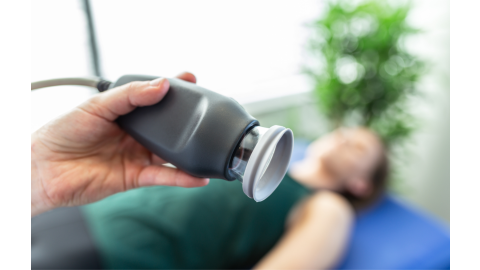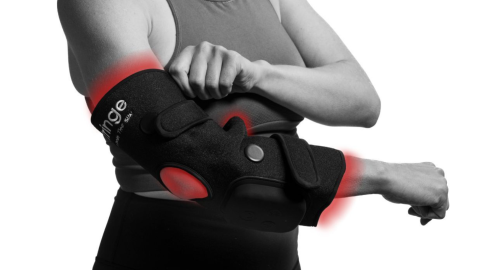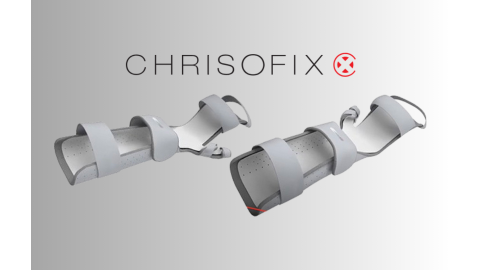Your body has nurtured another human for nine months and then labored to bring your bundle of joy into the world. As you read this now, you may not have slept, there may be spit up on your shirt, or maybe you’re pumping at work in the break room. No part of the motherhood gig is easy – all the more reason for you to be your strongest self.
This isn’t about body shaming or mommy shaming. Getting into your pre-pregnancy jeans is much, much lower on the list of priorities than having a strong and healthy body.
Where do you start with postpartum exercise?
The American College of Obstetricians and Gynecologists says that women can gradually start exercising again a few days after giving birth as long as their doctor agrees and there were no complications. But the key word here is gradually, and we’ll get to what exactly that means in a bit.
First, please consult with your doctor or midwife before starting any postnatal exercise program no matter what. They have your best interest at heart and they were there to see exactly what your body went through during your labor (not to mention, this is what they went to school for). Many doctors still maintain women should wait four to six weeks for their bodies to fully heal and it’s important to heed their specific medical advice. Your body needs time, especially if you had a caesarean delivery.
Once you do get the go ahead, please listen to your body. You aren’t just healing, you are also adjusting to your new role as mom and bonding with baby.
But when you are ready, walking is a great place to start. It may sound uninspiring, but a study in the New England Journal of Medicine found that walking during the postpartum period increases blood circulation and promotes healing, especially for women who have experienced perineum tears, episiotomies, or c-sections. Walking can even help prevent blood clots, which although rare, can happen up to 12 weeks after childbirth.
You can also start pelvic floor exercises and abdominal exercises in the first stage of postpartum exercise with a doctor’s permission.
What exercises will be helpful in the first stage of postpartum exercise?
Strengthening the Pelvic Floor
The first thing to do is to find and know where your pelvic floor muscles are. They span the width of your body and are slung between your tailbone and pubic bone. To be more specific, they are the muscles you tighten to stop urinating. Any of these exercises can be performed lying down, sitting, or standing.
Kegels are great for strengthening the pelvic floor. If you’ve never done them before, they’re actually extremely simple. Remember those muscles you use to stop urinating? Focus on them and slowly squeeze while increasing the tension until you have contracted the muscles as hard as you can. Release slowly.
Products to Strengthen Your Pelvic Floor
Vaginal Dilators
Used to restore vaginal width, depth, and elasticity, vaginal dilators are a great way to start relieving pain in the vaginal tissue and pelvic muscles. They come in progressively larger sizes to help progressively strengthen the pelvic muscles. For quicker results, use them in conjunction with relaxation techniques.
Yarlap Pelvic Floor Stim System
The Yarlap Pelvic Floor Stim System is a safe and comfortable way to strengthen and tone the pelvic floor muscles. Yarlap works by sending mild electrical signals to the muscles, essentially doing the workout for you. Choose from six different programs.
Kegel Exercise System
This is a set of progressively heavier Kegel weights to help strengthen the pelvic floor muscles. To use, gently insert the weight into the vagina like you would a tampon, using a water-based lubricant if necessary. Keep the weight inserted up to 15 minutes at a time, once or twice a day. With consistent use, the user will build stronger and tighter vaginal muscles that will improve bladder control and make for a faster childbirth recovery.
A Gentle Abdominal Exercise
Pregnancy literally splits your abdominal muscles down the middle. So it is incredibly important that you are completely healed before you do any vigorous abdominal exercises like crunches. Instead, be gentle with yourself and try this exercise. It strengthens the deepest muscle layer of muscle, the transversus abdominus, and you can perform it lying down, sitting, standing, or on your hands and knees.
- Keep your lower back flat.
- Breathe out and draw your belly button back towards your spine. Your lower back shouldn’t flex or move
- Hold this position and breathe lightly while counting to ten
- Relax and repeat up to ten times per set
- Do ten sets, as many times per day as you can while listening to your body
What exercises are helpful for stage two of your postpartum exercise program?
Focus on the Stomach
When the gap in your abdominal muscles has closed (and only then), you can proceed to more demanding exercises. Here are two we recommend:
- Lie on your back, with bent knees and both feet on the floor with your hands on your thighs
- Breathe out, contract your abdominal muscles, and lift your head and shoulders off the floor
- Slide your hands towards your knees, aiming to only get your shoulder blades off the floor
- Keep your head and shoulders stable
- Hold the position, then slowly ease your shoulders and head back to the floor
- Repeat up to ten times for one set
- Perform around three sets per session
The following exercise is ideal for the lower abdominal muscles located below your belly button. Work them gently with this exercise.
- Lie on your back with your knees bent and both feet flat on the floor
- Contract your abdominal muscles
- Slowly slide your feet away from you, aiming to straighten both legs while keeping your feet on the floor
- Try to straighten the legs without arching your lower back
- If your back starts to arch, stop and slide your feet back towards your bottom
- Aim for ten repetitions per set
What should you avoid when exercising postpartum?
You can actually cause more harm than good by exercising too soon or too hard. Give yourself a break. Not only because you’re a new mom (as if that isn’t a big enough reason itself!) but because you could hurt yourself if you don’t listen to doctors and your body.
Do not:
- Exercise too hard. Avoid intense cardio drills or excessive activity.
- Exercise too much. Be sure to pace yourself. The recommendation is roughly 150 minutes a week of exercise. This can be divided any way that works best for you, whether that’s 30 minutes, five days a week or ten minute increments a couple times a day.
- Exercise your abs the wrong way. Make sure they have completely healed and check for diastasis recti which is the separation of the abdominal muscles.
Your body is healed. Now what?
Once your body has healed, you can pace yourself to advance to other exercises. Here are some exercises that we recommend to tone and strengthen.
THERABAND Mini Ball Abdominal Curl
Goal: Build core strength and flatten your stomach
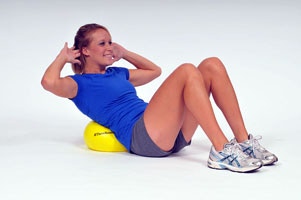
- Lay on your back with the small exercise ball under the small of your back
- Place your hands behind your head or on your chest
- Slowly lean backward over the ball, contracting your abdominals
- Return to an upright position and repeat
THERABAND Loop Hip Abduction
Goal: Sculpt and lift your bottom and strengthen hip abductors
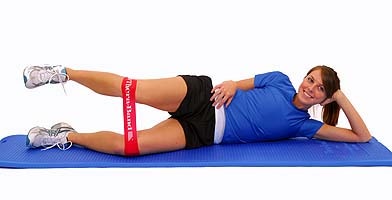
- Lay on your side with a medium-resistance loop around knees. Slightly bend your knees.
- Push the bottom knee into the mat while lifting the top knee against the band. Hold and slowly return to your original position.
Overhead Side Bend
Goal: Strengthen the trunk using a THERABAND Resistance Band to tone the abs, lower back, and lumbar region, while still going easy on your joints.
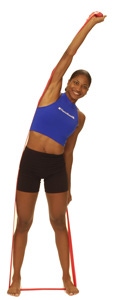
- Stand with your feet shoulder width apart, knees and hips slightly bent, and back straight
- Secure the middle of the band under your feet, grasp ends of band by your side
- Extend one arm with elbow straight overhead (opposite the side you are strengthening)
- Lean away, stretching the band
- Slowly return to your original position
Slow and steady wins the race when it comes to your postpartum exercise plan. Involve your doctor. Listen to your body. Be patient. Just like your baby will crawl before they walk, know that this is a process to be accomplished in stages. Most of all, know that you can do it.
Medical Disclaimer: The information provided on this site, including text, graphics, images and other material, are for informational purposes only and are not intended to substitute for professional medical advice, diagnosis or treatment. Always seek the advice of your physician or other healthcare professional with any questions or concerns you may have regarding your condition.

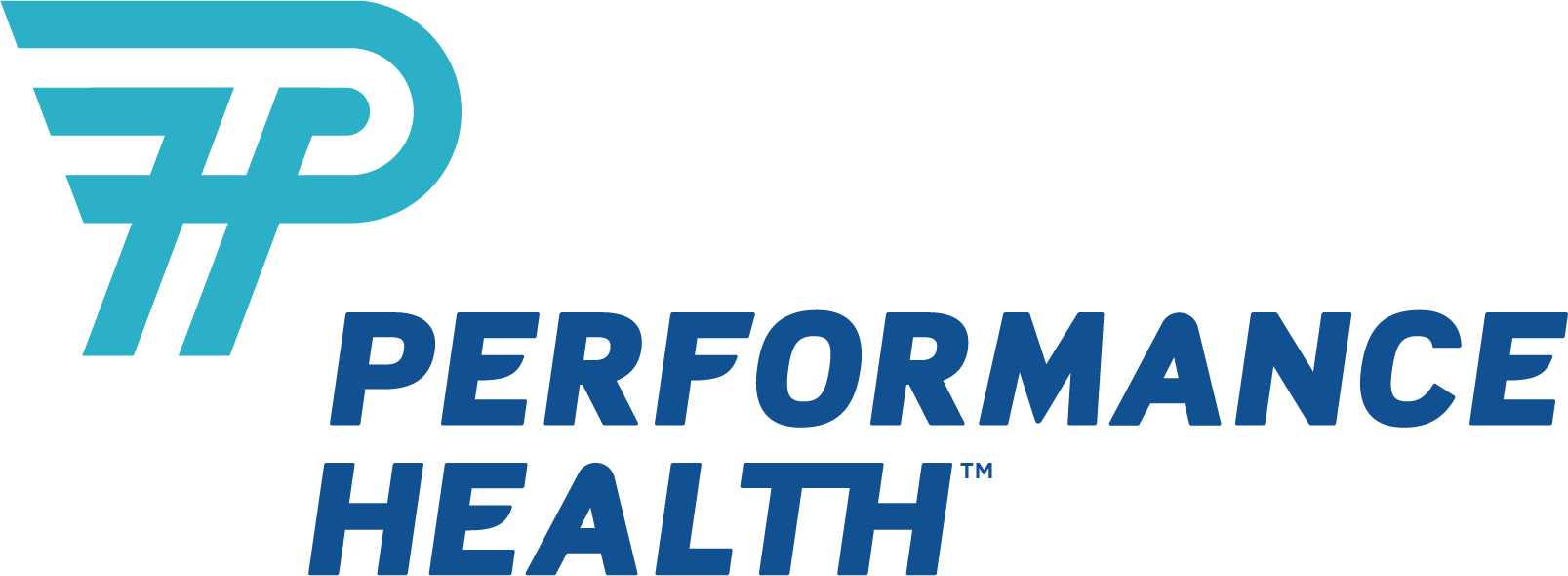






 France
France Australia
Australia
